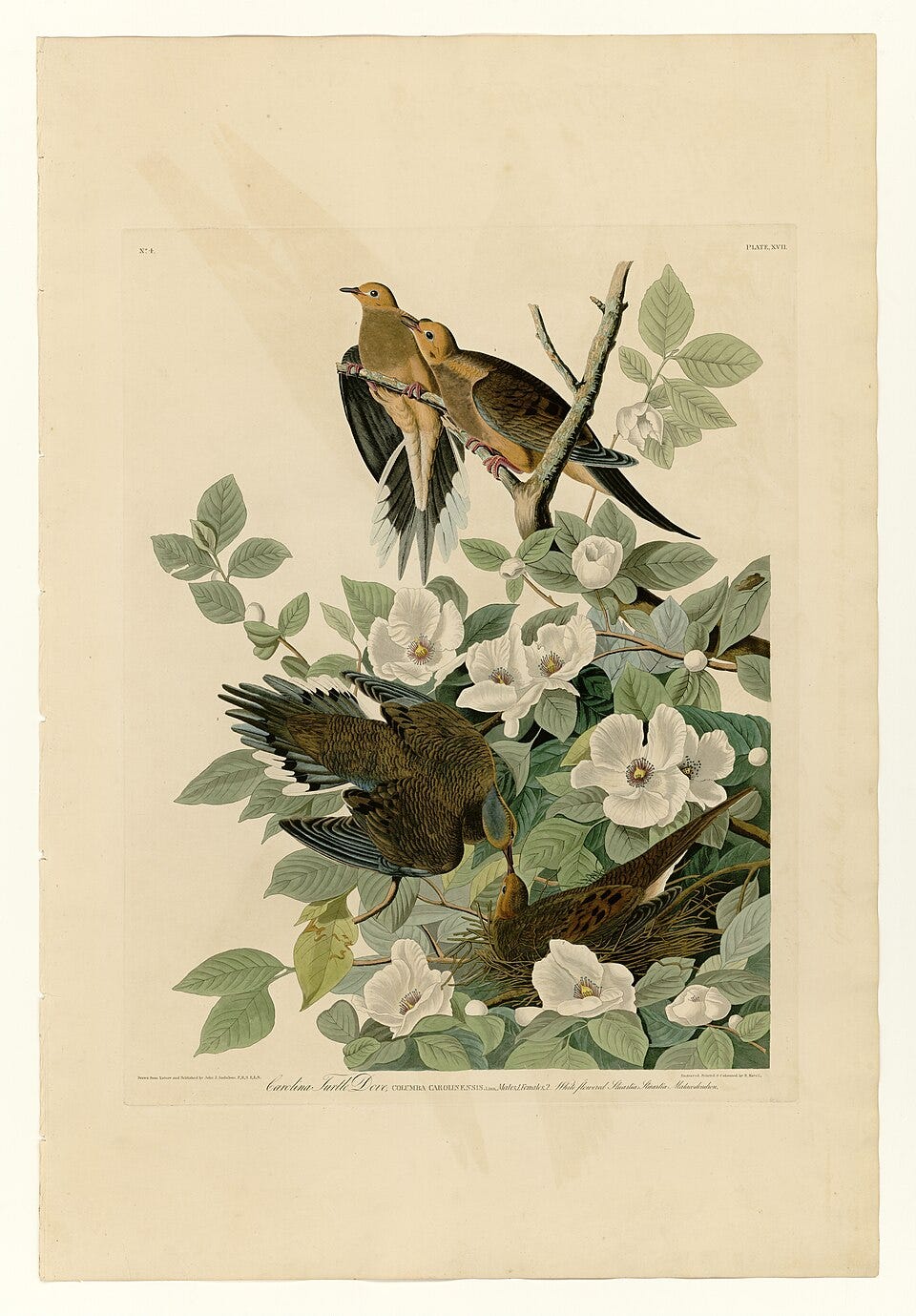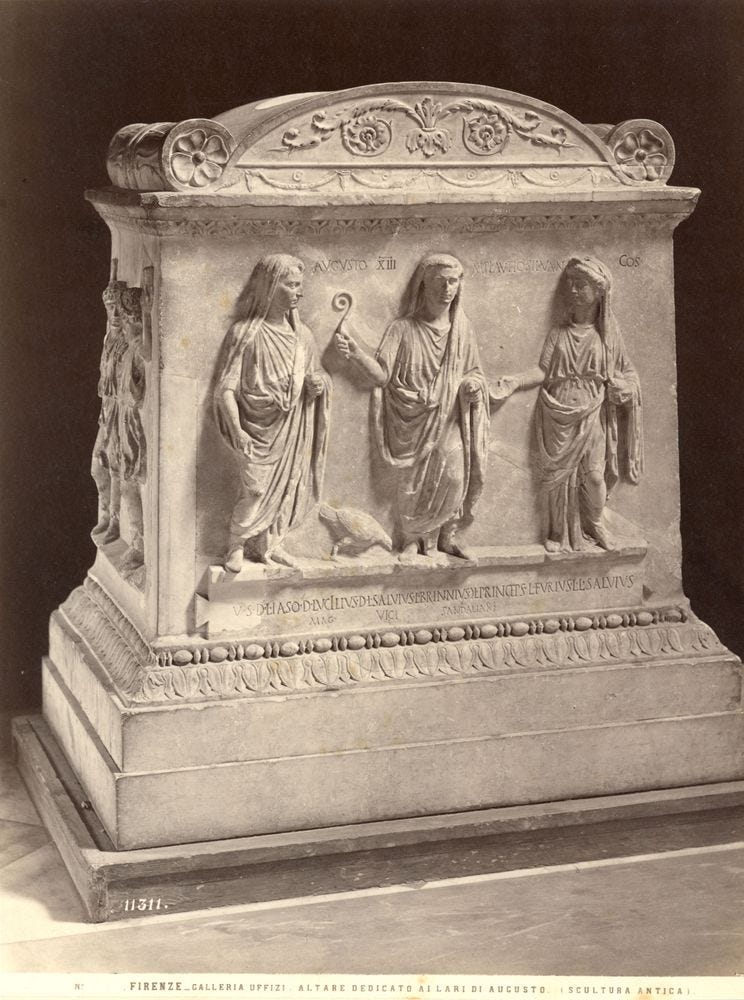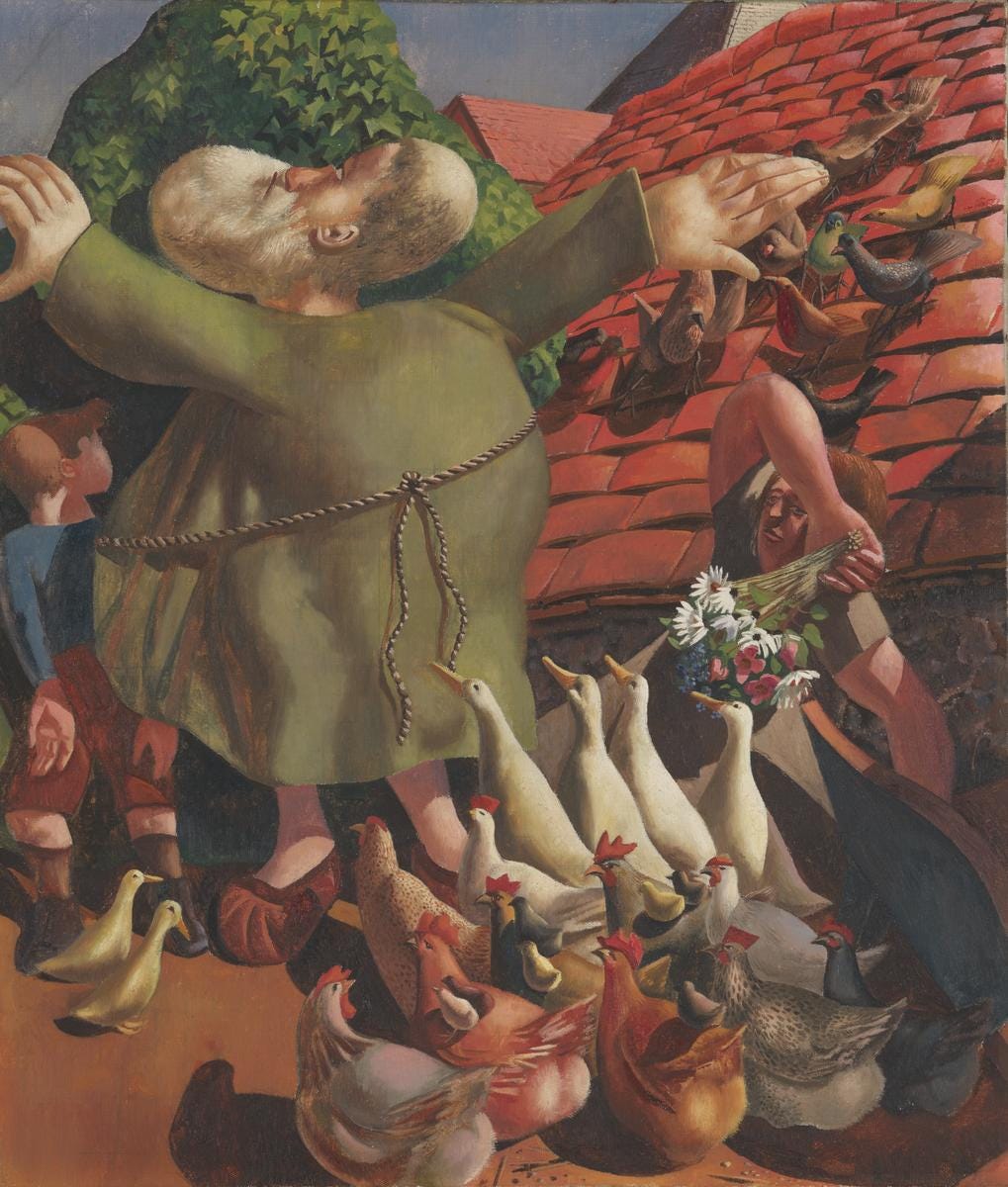on birds
auspices and cages

Music gives us practice in reading things we can’t understand.
— John Cage, Diary: How to Improve the World (You Will Only Make Matters Worse)
The function of art at the present time is to preserve us from all the logical minimizations that we are at each instant tempted to apply to the flux of events. To draw us nearer to the process which is the world we live in.
— For the Birds: John Cage in Conversation with Daniel Charles (trans. Richard Gardner)
Going back over old notebooks reveals the notetaker’s habitual preoccupations. Some are naturally short-lived, like chapters appearing for just a few pages. Others endure for years, reappearing in various guises, returning like serial characters with each installment. We keep ending up in the same part of the library. Themes emerge, recurring images, refrains. What first strikes the ear as dissonant soon folds back into atonality. “The piano ain’t got no wrong notes!” Thelonious Monk’s sharp rejoinder. Which is another way of saying what matters is our arrangements. I don’t just mean on the page, though that is often where we begin to arrange things; we keep shifting things around off the page too. Looking through our notes can then feel like sight reading sheet music. To play a piece of music cold, you have to feel into its propulsive rhythm, to fuse with its instrumentation. Between improvisation and rehearsal, the notes lift a little, start to get airborne. Black dactylic tracks flutter from our paper out the window, perch on telephone wires outside. Wherever we go, we begin to notice these avian accompanists, pick up their distinct arias among incessant cantatas of birdsong.
Walks. The body advances, while the mind flutters around it like a bird. (1907)
— The Journal of Jules Renard (trans. Louise Bogan)
On the afternoon of October 27, 1970, John Cage sat for a discussion with musicologist Daniel Charles in the Museum of Modern Art in Paris. The conversation would be published as part of a series of taped interviews by La Revue d’esthetique and collected by Editions Belfond in 1976 as Pour Les Oiseaux. When publisher Pierre Belfond asked Cage if the title was a joke, the avant-garde composer assured him it was not. “I am for the birds,” he reiterated, “not for the cages in which people sometimes place them.” His reply is characteristically Cagian, both playing on his surname and working as humorous koan. Drawing out Cage’s Taoist philosophy, Charles states in his preface to the English edition of the book, is in fact his “sole aim” in the conversation. To illustrate this, he borrows from Octavio Paz’s preface to The Bow and the Lyre:
When Chuang-tze explains that the Tao experience implies a return to a sort of elementary or original frame of mind, where the relative meanings of language are inoperative, he resorts to a play on words that is a poetic riddle. He says that this experience of a return to what we are originally is like “entering a cage of birds without making them sing.” Fan means “cage” and “return”; ming, “song” and “names”. The sentence, therefore, equally means “to return to the place where names are superfluous,” to silence, to the kingdom of the obvious. To the place where names and things melt into one: to poetry, the kingdom where naming is being.
Besides echoing Cage’s own name play, the passage is doubly apt in that it offers a framework for the composer’s skepticism toward artificially imposed order in conventional music composition. Cage’s compositions buck all formal expectations. He frames such non-conformism in ecological terms, telling Charles, “No, in music, there can be much organization or a lot of disorganization—everything is possible. In the same way, the forest includes trees, mushrooms, birds, anything you wish.” For Cage, organization is not an artistic process but a pragmatic one, appropriate only for the management and distribution of those utilities and resources necessary for survival. He goes on: “But today, we must consider the ecology even more than the individual. It is not simply by observing the individual, but by reintegrating individuals into nature, by opening the world to the individual, that we will get ourselves out of this mess. Instead of continuing, as in the past, to separate ourselves from each other, instead of being proud of our petty emotions and our little value judgements, we must open ourselves up to others and to the world in which we find ourselves.” Order misapplied to aesthetics is not only unnatural in Cage’s view, it is emblematic of our exile from the garden, that original kingdom where naming began.
My young brother asked even the birds to forgive him. It may sound absurd, but it is right none the less, for everything, like the ocean, flows and enters into contact with everything else: touch one place, and you set up a movement at the other end of the world. It may be senseless to beg forgiveness of the birds, but, then, it would be easier for the birds, and for the child, and for every animal if you were yourself more pleasant than you are now. Everything is like an ocean, I tell you. Then you would pray to the birds, too, consumed by a universal love, as though in ecstasy, and ask that they, too, should forgive your sin. Treasure this ecstasy, however absurd people may think it.
— Fyodor Dostoevsky, The Brothers Karamazov (trans. Richard Pevear & Larissa Volokhonsky)
Two cardinals. The first time I saw a cardinal was in the woods near Lake Pleasant, Massachusetts.1 My partner’s aunt had lent us her cabin as a retreat to write and recharge after visiting family in his neighboring hometown. Looking out the window our last morning there, I saw a vivid puff of crimson popping out against a backdrop of dusky green leaves. I’d hoped to see a cardinal on that trip, having grown up in California, well outside their range. Other than their geographic remoteness, I couldn’t have said why I’d wanted to see one, until of course I did. It’s a beautiful bird. It sat for a moment, primping its feathery vestments and whistling. I didn’t think to take a picture, but the image has stayed with me since.
The sparrows say of us: “They build houses so that we can build nests in their walls.” (1905)
— The Journal of Jules Renard (trans. Louise Bogan)
For some reason we each had separate flights home that day, both with connections in Houston, mine landing first. On my layover I passed the time by writing a note to my partner in which I described the grackles I’d seen roosting in the trusses of the airport terminal ceiling, and the cardinal, thumping around in the trees, I wrote. A feathered heart I’d left behind at his Aunt Jeri’s. When my flight began to board I placed the note in a tall ficus I’d seen on the way to the gate and sent a photo as a clue. But his layover was shorter, and his gates farther apart than mine, so he never found it. “Missed connections,” we joked later.

The second time I saw a cardinal was in a field near the Brazos River just outside of Cleburne, Texas.2 I’d made the trip down with family after my mother’s memorial in Kingfisher, Oklahoma, to camp and view the solar eclipse in its path of totality. The eclipse lasted about three and a half minutes, casting us in eerie silver emulsion, stunning birds and local wildlife. Afterwards I walked up the path from the riverbank to a road skirting the field we’d passed on the way to our site. At first approach the field looked like just a clearing ringed by riparian woods. But as I passed through it, intricate details emerged: bluebonnets, phlox, yucca, Indian paintbrush; fuzzy caterpillars and fat bumblebees; between two trees at the distant edge of the field, a small group of deer grazing; and as I followed the dirt road toward a lone tree at the center, a bright red cardinal trailing at my right, landing on an outstretched branch above a thicket at the side of the road. “Hi mom,” I said, not quite knowing why.3
The world is a mist. And then the world is minute and vast and clear. The tide is higher or lower. He couldn’t tell you which.— Elizabeth Bishop, “Sandpiper”
In Cherokee spiritual tradition there is a tale about the darkening of the earth when the sun’s daughter is killed.4 Messengers tell the Cherokee they must bring back the sun’s slain daughter in a box from the ghost country in the West known as Night Land. If they return her to her mother without opening the box, light will be restored to their darkened homeland. The Cherokee do this, but on the way back they open the box a crack to let her breathe. They hear a fluttering inside the box, and a redbird flies out and lands in a nearby thicket. The beautiful redbird’s song brings out a smile in the sun and light is restored because, the Cherokee now know, the cardinal is the sun’s daughter.
In An Unpublished Notebook, editor Mireille Duchene studies Virginia Woolf’s “scribbled notes on the Greek and Latin classics which she had read avidly since adolescence,” searching for instances of the author’s self-identification with subject matter. Duchene listens for echoes of Woolf’s personal losses in the “ancient voices” she annotates in the aftermath of her brother’s death following a trip to Greece in 1907, only recently having lost her father to cancer, and already having lost both her mother and half-sister as a teenager. After the loss of her mother at 13, Woolf had suffered her first mental breakdown. She had another breakdown following her father’s death, during which she heard sparrows singing in Greek, an episode she integrates into her 1925 novel Mrs. Dalloway.
The choruses, sung by sailors, have a rough kind of beauty and pathos: they long for home & love, are kept out here on the shore, wet with sea mists.
— Virginia Woolf, An Unpublished Notebook
Poet and short story writer Elizabeth Bishop had a peculiar affinity for birds, which appeared as fixtures in her life as well as her writing. As a child she’d dreamed about an owl riding on the back of a rabbit, something she related to her friend and Vassar roommate, the painter Margaret Miller, who later found an uncanny reproduction of the mystical image in an illustrated manuscript. Bishop loved it so much she had the image made into a seal that she used for letters to friends from then on.5 She had a penchant for acquiring pet birds: on a trip to Europe she bought three owls in Rome that she intended to bring home (one as a gift for Marianne Moore), but that were impounded by customs on her arrival in New York;6 she brought a canary with her to Washington when invited to record her poetry for the Library of Congress; she owned a pet toucan named Sammy (until accidentally poisoning him when attempting to treat him with an insecticide for fleas), and a mynah bird named Jacob that she taught to recite mantras and phrases from favorite poems, such as “awful but cheerful,” “I too dislike it,” and “nobody knows.”7
Ovid, Cato, Petronius and Pliny all mention the art of teaching birds the rudiments of conversation, whereas Cicero’s silence on this matter could be seen as a silent reproach of the practice. Later, Clement of Alexandria scolded women who tried to teach their nightingales. And yet look at where we are now. We hardly read Cicero, Clement of Alexandria wouldn’t manage to find a publisher for his Hypotyposes, Madame, Mademoiselle, Monsieur, your work unfortunately does not quite fall within the constraints of our list—but each night, in spring, in the gardens and the undergrowth, rise the sad songs of the Roman and Greek women they found so frivolous.
— Éric Chevillard, Palafox (trans. Wyatt Mason)
Streptopelia decaocto. In Balkan legend, the Eurasian collared dove was created to emancipate a poor servant who prayed to the gods to expose her miserly employer for refusing to increase her salary. Zeus sympathizes with her case and transforms her into a dove who calls out “eighteen” to shame her mistress for paying just eighteen pieces for a year of hard labor. The collared dove’s amphibrachic call is an onomatopoeia in Hungarian, Romanian, and several Balkan languages, in which eighteen is a trisyllable. Carl Hinke, an ornithologist and bird collector who delivered the first specimens of the dove for the Hungarian Natural History Museum in Budapest, passed the legend on to the Head of the Department of Zoology at the Hungarian National Museum, Imre Frivaldszky, who then gave the bird its numerical epithet.8
or for example that old servant who had an exemplary life and death never any arguments not that with her nail tapping a tooth not that no arguments with Mr. or Mrs. on the subject of that frightful question of salaries no birds set an example a proper example the example of birds — Jacques Prévert, “Birds, At Random”
The Swallow and the Little Birds. Jean de La Fontaine’s verse adaptations of Aesop’s fables artfully expand upon the traditional folktales to satirize 17th century French aristocracy and politics.9 The son of a maître des eaux et forets (a provincial supervisor of woods and waterways) in Château-Thierry, the unlikely poet was in his 40s when he began the project, sometime after the sudden political imprisonment of Nicolas Fouquet—finance minister and generous patron to La Fontaine—by a young, autocratic Louis XIV in 1661. Fouquet, who was arrested on charges of embezzlement and lèse-majesté (defamation or disrespect of the king) following a lavish gala at the minister’s Baroque château, would remain in prison until his death.10

In La Fontaine’s version of “The Swallow and the Little Birds,” a migrating swallow learns to foretell danger by reading signs in weather and agriculture. When she observes farmers sewing crops of hemp that will later be harvested and used to make snares and traps, she tries to warn the local field birds. She instructs them to eat the hemp seed before it sprouts, and pull any seedlings up by their roots to eradicate the ominous crop. Otherwise, she predicts, “Imprisonment or death will be your fate; / their cages and their cooking-pots await.” But the little birds mock the swallow and ignore her “prophecies of doom.” La Fontaine ends with an allusion to the tragic myth of Cassandra, whose prescient visions of the fall of Troy were similarly ignored. “In neither case,” the verse concludes, “were many saved: / most of the birds and Trojans were enslaved.”11
If you enjoyed this post you might like...
I recently learned that Lake Pleasant was founded as an early Spiritualist community and resort, and is believed to be the oldest continuously existing Spiritualist community in the country.
Named for Confederate General Pat Cleburne, an Irish immigrant who settled in antebellum Arkansas. Cleburne’s rising military career stalled in 1863 after his controversial proposal, following Lincoln’s Emancipation Proclamation earlier that year, to emancipate southern slaves and enlist them in the Confederate Army. Citing the contributions of galley slaves to a Christian victory at the Battle of Lepanto, and slave rebellions in Haiti and Jamaica, Cleburne argued the promise of freedom would motivate enslaved soldiers and help prevent an imminent loss he foresaw for the Confederacy. His proposal was ultimately discredited as abolitionist conspiracy, and Cleburne would be passed over for further promotion until his death at the Battle of Franklin the following year.
My mother’s last letter before she died was a family newsletter at Christmas in 2023. She ends the letter by wishing everyone a better year in 2024, adding, “but I’m not betting on it.” The letter arrived folded in quarters inside an Arbor Day Foundation holiday card. On the front is an image of a cardinal.
Recorded in James Mooney’s 1900 Myths of the Cherokee. Contemporary storyteller Freeman Owle concludes his version in Living Stories of the Cherokee: “It is a story about darkness and light and birdsong.”
See Mark Ford’s essay, “Elizabeth Bishop’s Aviary,” for London Review of Books.
Bishop and Moore were close friends, having been introduced by Fanny Borden, a librarian and the niece of Lizzie Borden.
Moore began translating the fables of La Fontaine while caring for her mother, who died in 1947. Moore’s translation would be published in 1954.
Twenty years after her death, the final lines of “The Bight” were engraved on the Bishop family monument in accordance with the poet’s wishes: “All the untidy activity continues, / awful but cheerful.”
The North American mourning dove (Zenaida macroura), once known colloquially as the Carolina turtle dove, is named for its plaintive call, a trochee followed by a dactyl.
In Greek and Latin elegiac poetry the most common meter is the elegiac couplet, a line of dactylic hexameter followed by a line of dactylic pentameter.
In defense of his longer verses, La Fontaine points to the example of Socrates, who put the fables into verse as a distraction while awaiting execution in prison.
The gala was the occasion of Molière’s first production of Les Fâcheux, considered the first example of the comédie-ballet.
Jean de La Fontaine, Selected Fables, trans. Christopher Betts.




